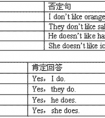找出错误并改正。( ) 1.What would you like haveforlunch?A B C D( ) 2.What your favourite food? AB C D ( ) 3.What do youhave on lunchonMondays? A B C D( ) 4.-五年级英语
题文
| 找出错误并改正。 |
| ( ) 1. What would you like have for lunch? A B C D ( ) 2. What your favourite food? A B C D ( ) 3. What do you have on lunch on Mondays? A B C D ( ) 4. Bananas is my favourite fruit. A B C D ( ) 5. It's time for go to bed. A B C D |
答案
| 1. D have-to have 2. A What-What's 3. D on-for 4. B is-are 5. C for-to |
据专家权威分析,试题“找出错误并改正。( ) 1.What would you like haveforlunch?A B..”主要考查你对 动词不定式,介词,系动词 等考点的理解。关于这些考点的“档案”如下:
动词不定式介词系动词
考点名称:动词不定式
- 不定式定义:
由to+动词原形构成。不定式是一种非限定性动词。而非限定动词是指那些在句中不能单独充当谓语的动词,可分为不定式,动名词,现在分词和过去分词。
“动词不定式”由动词+不定式构成。动词不定式在句中可以作句子除谓语之外的任何句子成分。动词不定式的被动形式除了一般形式外还有其完成式和进行式。
常见的有:like / love,want,need,ask,help等。
例:I like to play with Tom. 我喜欢和汤姆玩。
I want to play with Tom. 我想和汤姆玩。
I like to eat dumplings. 我喜欢吃饺子。 - 动词不定式一般结构:
疑问词who,what,which,when,where,whether,how后可接不定式构成不定式短语,在句中作主语、宾语、表 语等。如:
①When to leave for London has not been decided yet. (不定式在句子中做主语)
②Mr. Smith didn't know whether to leave or stay there. (不定式在句子中做宾语)
③I asked Professor Xu how to learn English well. (不定式在句子中做直接宾语)
④The question was where to get the medicine needed. (不定式在句子中表语)
以上例句中疑问词+不定式部分,均可转换为相应的从句形式。如:
①When we shall leave…
③…how I could learn…
经常在这种结构中使用的动词有:
consider,decide,discover,explain,find out,forget,hear,know,lea rn,observe,understand,wonder等。 - 动名词与不定式的区别:
1 动名词与不定式的区别:
动名词表达的是:状态,性质,心境,抽象,经常性,已发生的
不定式表达的是:目的,结果,原因,具体,一次性,将发生的
2 接不定式或动名词,意义相同。
3在下列情况下,一般要用不定式:
①hate,like,love前有would(should)时,
如:I'd like to have a cup of coffee.
②当谓语动词begin,continue,start等是进行式时,
如:Thestudents are starting to work on the di fficult maths problem.
③begin,continue,start与know,understand等状态动词连用时,
如:I soon began to understand what was happening.
④.advise,allow,encourage,forbid,permit等动词后接动名词作宾语,或带不定式作宾语补足语。如:
Our teachers don't permit our/us swimming in the lake.
Our teachers don't permit us to swim in the lake.
4 部分动词后接不定式或动名词时,意义差别较大,应根据句子语境选择使用。
forget,remember,regret后接不定式,表示现在或未来的动作,接动名词表示动作已经发生。如:
Don't forget to post the letter for me.
Have you forgotten meeting her in Beijing Airport?
Remember to close the windows before you leave.
I remember writing him a letter a year ago.
We regret to tell you that all of you are not invited toattend the meeting.
They regretted ordering these books from abroad. - 省to的动词不定式:
(1)情态动词( 除ought 外,ought to意思是“应该”,是情态动词,只有一种形式,后边接动词不定式,to不能省略。
ought to没有人称和数的变化,后接动词原形可以表示现在、将来或过去将来,由时间状语或上下文决定。例如:
They ought to come tomorrow.他们明天应当来):
- 最新内容
- 相关内容
- 网友推荐
- 图文推荐
上一篇:Iwantanewdress.[ ]A.tobuyB.buyingC.buy-四年级英语
下一篇:It'stimeTV.[ ]A.watchingB.watchesC.towatch-五年级英语
零零教育社区:论坛热帖子
| [家长教育] 孩子为什么会和父母感情疏离? (2019-07-14) |
| [教师分享] 给远方姐姐的一封信 (2018-11-07) |
| [教师分享] 伸缩门 (2018-11-07) |
| [教师分享] 回家乡 (2018-11-07) |
| [教师分享] 是风味也是人间 (2018-11-07) |
| [教师分享] 一句格言的启示 (2018-11-07) |
| [教师分享] 无规矩不成方圆 (2018-11-07) |
| [教师分享] 第十届全国教育名家论坛有感(二) (2018-11-07) |
| [教师分享] 贪玩的小狗 (2018-11-07) |
| [教师分享] 未命名文章 (2018-11-07) |


![I want to ______________a science teacher one day![ ]A. beB. isC. are-六年级英语](http://www.00-edu.com/d/file/ks/4/1/58/2019-08-28/small0786c619dff6ea7cc013f1222e770e571566922364.png)
![Let's get ____ work![ ]A. on B. inC. to-四年级英语](http://www.00-edu.com/d/file/ks/4/1/58/2019-08-28/smallaeead033e0df4ab64ad92e4eecbe84ed1566922686.png)
![It's 10 o'clock. It's time_________go to school.[ ]A. toB. forC. of-四年级英语](http://www.00-edu.com/d/file/ks/4/1/58/2019-08-28/smallcbd5ebed803baef3505fe0cd5bc985461566922628.jpg)

